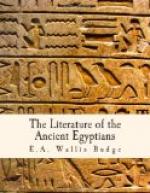The Egyptians believed that the souls of the dead on leaving this world had to traverse a vast and difficult region called the Tuat, which was inhabited by gods, devils, fiends, demons, good spirits, bad spirits, and the souls of the wicked, to say nothing of snakes, serpents, savage animals, and monsters, before they could reach the Elysian Fields, and appear in the presence of Osiris. The Tuat was like the African “bush,” and had no roads through it. In primitive times the Egyptians thought that only those souls that were provided with spells, incantations, prayers, charms, words of power, and amulets could ever hope to reach the Kingdom of Osiris. The spells and incantations were needed for the bewitchment of hostile beings of every kind; the prayers, charms, and words of power were necessary for making other kinds of beings that possessed great powers to help the soul on its journey, and to deliver it from foes; and the amulets gave the soul that was equipped with them strength, power, will, and knowledge to employ successfully every means of assistance that presented itself.
The OBJECT OF THE BOOK OF THE DEAD was to provide the dead man with all these spells, prayers, amulets, &c., and to enable him to overcome all the dangers and difficulties of the Tuat, and to reach Sekhet Aaru and Sekhet Hetep (the Elysian Fields), and to take his place among the subjects of Osiris in the Land of Everlasting Life. As time went on the beliefs of the Egyptians changed considerably about many important matters, but they never attempted to alter the Chapters of the Book of the Dead so as to bring them, if we may use the expression, “up to date.” The religion of the eighteenth dynasty was far higher in its spiritual character generally than that of the twelfth dynasty, but the Chapters that were used under the twelfth dynasty were used under the eighteenth, and even under the twenty-sixth dynasty. In religion the Egyptian forgot nothing and abandoned nothing; what was good enough for his ancestors was good enough for him, and he was content to go into the next world relying for his salvation on the texts which he thought had procured their salvation. Thus the Book of the Dead as a whole is a work that reflects all the religious beliefs of the Egyptians from the time when they were half savages to the period of the final downfall of their power.
[Illustration: Vignette and Part of the XCIInd Chapter of the Book of the Dead. (Ani and his Soul are leaving the Tomb) From the Papyrus of the Ani in the British Museum.]
The Theban Recension of the Book of the Dead contains about one hundred and ninety Chapters, many of which have Rubrics stating what effects will be produced by their recital, and describing ceremonies that must be performed whilst they are being recited. It is impossible to describe the contents of all the Chapters in our limited space, but in the following brief summary the most important are enumerated.




